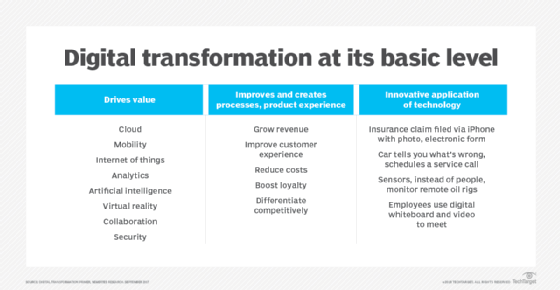
Fotolia
Digital transformation hinges on information governance policies
Data governance is an important part of any digital transformation plan. The trick is to lead with the governance tools that ensure the digitization strategy is a success.
Digital transformation has been a hot topic for years now. For most of that, the traditional information governance expert had been left sitting on the sidelines after trying, and most often failing, to become involved. This is in part because information governance is viewed as a source of additional rules and requirements that slow down any transformation efforts.
The reality is that involving information governance experts early on can accelerate digital transformation efforts. The trick to becoming involved is to not lead with the end-goals of information governance policies but to offer up the governance tools that can make any digital transformation plan successful.
Remember the goal
While many organizations debate the definition of information governance, the core principle is gaining control over an organization's information assets. The problem is that the word "control" scares a lot people. They equate control with loss of freedom. Unfortunately, this is directly due to the all-or-nothing approach that many information governance professionals have taken over the years.
When information governance policies are executed correctly, control means simply knowing where information lives, who has access to it, and how it is used. Information governance is not about locking content into virtual file cabinets. It is about making sure that the right people can access information at the right time and have confidence that the information is trustworthy.
This is also one of the key goals of digital transformation efforts. We live in a digital world that is driven by information. This information is created in one place and moves through different processes, leaving remnants behind. Digital transformation plans create streamlined ways of getting things done where the information needed is always available.
To do that, you need to know where that information lives and how to access it. More importantly, you must have full confidence that the information is correct and not outdated or incomplete. This is a prerequisite for a successful transformation project and it is at the core of how information governance policies achieve success.

Map the information flow
Most information professionals have been mapping information for years. Even with paper records, the progress of a case file through the organization from creation to its final resting place in records was well documented.
Need the latest address for a customer? That was collected on Form 11A. Today it resides in the CRM. Information became digital, but the mapping skills remained the same. The destinations and linkages have simply evolved.
In the paper world, processes were linear. When electronic workflow was introduced, we improved the routing and processing capacity, but we didn't always deviate from a linear path. Eventually, people realized that digital information can go to multiple places, creating parallel work streams on the same information. Still, information stayed within its own system unless it was copied, emailed or printed.
With today's technology, information in one system can readily be accessed in every other system simultaneously. Instead of mapping the flow of information through a process, information professionals can identify the sources of data, which processes access the information and what actions create changes to the information.
Speeding up digital transformation
Every digital transformation team needs people who know the data. The team needs to know where it is, what can be done to it and how to get to it. These are the questions that a good information governance expert can provide. They have either already determined the answer or know exactly who to ask.
More importantly, information is going to move from the point of creation to the systems of records, and accessed for delivery along the way. Knowing how all of that happens is critical for information governance professionals to do their jobs.
What the traditional information governance professional needs to keep in mind is that the hard-core records management requirements need to wait. Information needs to be captured and classified so that it can be used effectively. Restricting updates of data to reliable sources versus allowing all systems to change it are basic rules that can be implemented. With that in place, formal records management can readily be added later.
Once people are working in their digital environment and you actually have complete and accurate records, it's time to plan for long-term management. You cannot manage what you don't have, and you don't want to enshrine bad information. A digital transformation allows companies to collect, process and validate information across the organization, and adding to the long-term business policies is much more straightforward. This is also more important for companies that must comply with the E.U.'s General Data Protection Regulation (GDPR) in effect May 25, 2018.
Plan around live records
The biggest change is going from focusing on the long-term management of information to making sure that information is available on demand. There needs to be protections from improper updates, but there should be a focus on enabling access to information. Adding any is the fastest way to being shut out of the entire transformation effort.
Digital transformation provides opportunities to implement information governance policies to use and govern information better, while ensuring GDPR compliance. Achieving transformation and governance goals in the same effort is an opportunity that should not be missed.








